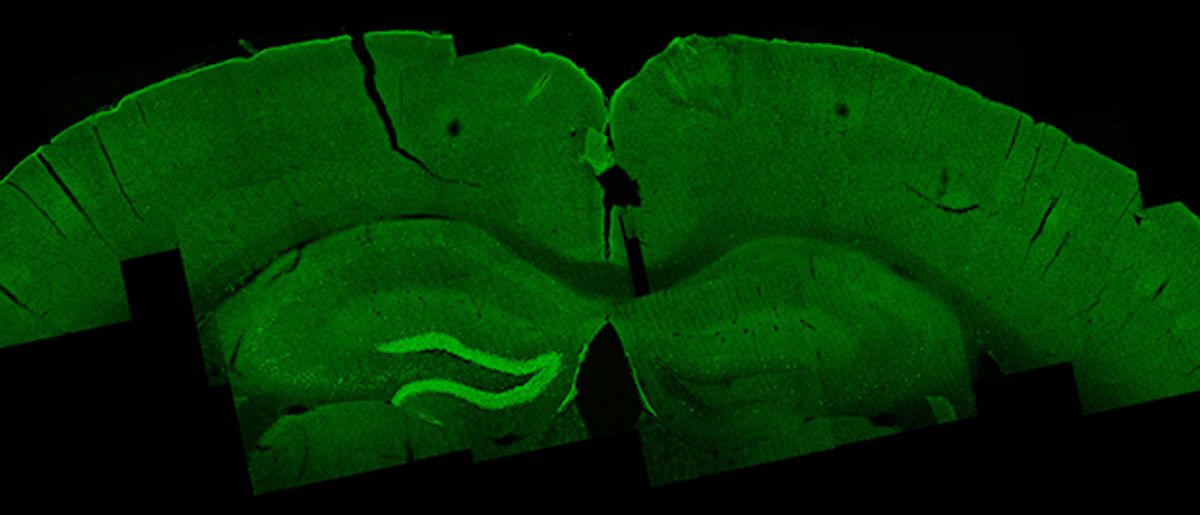When Edward Boyden and Nir Grossman at the MIT Media Lab in the spring of 2014 met for a brainstorming session, they made a list of every possible way one could artificially excite brain cells. They produced a long list that included variations on multiple types of energy—electric fields, ultrasound, magnets, light—each with significant drawbacks. But there was one promising method on the list that hadn’t been tried on the brain.
They called it temporal interference—a take on electrical stimulation—and in a paper published today in Cell, they describe how they successfully used this method to selectively and non-invasively excite deep structures in the mouse brain. If it can be refined, the technique could be used as a research tool to better understand the brain’s neural circuits. It might also offer a non-surgical treatment option for people with central nervous system disorders such as Parkinson’s disease.
For decades, researchers have been experimenting with electrical stimulation of the brain to do things like treat serious disease and improve athletic performance. The communication between neurons is, after all, just an electrical signal, and that activity can be induced or interrupted artificially by an external electrical pulse. The idea behind therapeutic electrical stimulation, or electroceuticals, is to get neural circuits firing in areas of the brain that might not be functioning optimally.
The most advanced and precise method—deep brain stimulation—involves surgically implanting electrodes in the brain. The technique is known to ameliorate symptoms of Parkinson’s disease and obsessive compulsive disorder, and researchers have experimented with using it to treat other conditions such as depression and epilepsy. But it can be hard to justify such an invasive surgical procedure for less serious conditions.
There’s a non-invasive technique called transcranial direct current stimulation (tDCS), in which electrodes are placed on the scalp. Researchers, companies, and even DIY brain hackers have been experimenting with the method in an attempt to treat disease and improve skills. But this non-invasive approach lacks specificity. The electric fields tend to activate everything in their path. So if the pulses are aimed at a deep brain structure such as the hippocampus, they’re likely to activate more superficial structures along the way as well.
Boyden and Grossman wanted to activate deep brain structures without stimulating the overlying tissue. And they wanted to do it without surgery. So they engineered the electrical fields to exploit the physical properties of neurons.
Neurons typically don’t respond to high frequency electric signals. But they do respond to low frequency signals. Boyden and Grossman hypothesized that if they sent to a deep brain target two high frequency signals that differed by a small amount, the signals would pass through the more superficial tissues of the brain. When these signals interfered with each other at the target, they would create a field with an amplitude that oscillates at a frequency equal to the small difference between the two high frequency signals. That electrical wave would be low enough to engage neurons.
For example, if they send two high frequency signals—one at 2000 hertz (Hz) and the other 2010 Hz—to a target in the brain, the signals at that point will interfere with each other, creating an electrical wave that oscillates at the difference frequency of 10 Hz. That’s low enough for neurons to follow. The 10 Hz signal only reaches neurons at the point of interference: a pocket of tissue where the amplitude change is created. All the other superficial brain tissue through which the high frequency signals passed remain unaffected.
Boyden and Grossman tested their temporal interference concept in living mice. Using electrodes placed on the rodents’ heads, they excited neurons in the hippocampus. In a separate experiment, they targeted neurons in the cortext and induced movement in the rodents’ ears, paws and whiskers. Using a detection technique called c-fos labeling, they confirmed that the signals stimulated only the target areas of the brain in the hippocampus, and not the overlying regions such as the cortex.
The researchers admit they aren’t sure exactly how temporal interference works. “My theory is that the neurons act kind of like an AM radio,” says Boyden. In AM radio, the announcer’s voice goes through the air on a high frequency signal, and when the receiving radio picks it up, it extracts the low frequency—the announcer’s voice—for the listener to hear. “We think the brain works like that. You transmit two high frequency signals and the neurons will extract the low difference frequency, which drives their activity,” says Boyden.
The stimulation delivered by the temporal interference method isn’t as precise as deep brain stimulation in which electrodes are surgically placed in the brain. That’s something the researchers are going to work on next. “We need to make it more focal,” says Boyden. “The volumes of brain that we activate are much bigger,” than those activated by implanted electrodes, he says. “But I think we can trim that by additional mathematics and engineering.”
Boyden and his team plan to experiment with the configuration of the electrodes, the number of electrodes, and the frequencies. They also want to test the technique on human volunteers, and have begun planning that study.
“If we can non-invasively stimulate deep parts of the brain, we can better understand how the brain works, and we can also help patients without the need for surgery,” Boyden says.
Emily Waltz is a features editor at Spectrum covering power and energy. Prior to joining the staff in January 2024, Emily spent 18 years as a freelance journalist covering biotechnology, primarily for the Nature research journals and Spectrum. Her work has also appeared in Scientific American, Discover, Outside, and the New York Times. Emily has a master's degree from Columbia University Graduate School of Journalism and an undergraduate degree from Vanderbilt University. With every word she writes, Emily strives to say something true and useful. She posts on Twitter/X @EmWaltz and her portfolio can be found on her website.



